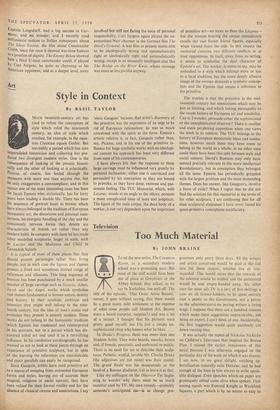Art
Style in Context
By BASIL TAYLOR MUCH twentieth-century art has tried to refute the conception of style which ruled the nineteenth century, an idea of style which resulted, for example, in the equa- tion Christian equals Gothic. But inevitably a period which has seen Unparalleled historicism and collecting has pro- duced two divergent modern styles. One is the Consequence of looking at the present histori- cally and the other of looking at it eclectically. Picasso, of course, has leafed through the Museums with more zest than anyone else, but he only exaggerates a commonplace; and in this matter one of the most interesting cases has been Sir Jacob Epstein who, stylistically, has for forty Years been leading a double life. There has been his sequence of portrait busts in bronze which have always belonged to the tradition of European humanistic art; the distortions and personal man- nerisms, his energetic handling of the clay and the consistently nervous forms they denote are characteristic of Jewish art rather than any modern habit. In company with these he has made other modelled sculptures, larger in scale, such as Lucifer and the Madonna and Child in Cavendish Square.
It is typical of most of these pieces that they should present personages rather than living people, but in each case the figures and themes possess a fixed and sometimes limited range of references and allusions. This long sequence of bronzes has been punctuated by a much smaller number of large carvings such as Genesis, Adam, Jacob and the Angel, works which symbolise vast themes fundamental to human nature, destiny and history. In their symbolic ambition and intention they might well belong to the nine- teenth century, but the idea of man's status and evolution they present is entirely modern. These works do not belong to the humanistic tradition which Epstein has reassessed and reinterpreted in his portraits, but to a period which has dis- covered tribal art and used it as a revivifying influence. In his combative autobiography he has warned us not to look at these pieces through an experience of primitive sculpture, but in spite of the warning the references are unmistakable and exact parallels can easily be recognised.
Since Gauguin, artists have, used primitive art as a means of escaping from outmoded European forms and styles, leaving out of account their magical, religious or social sources; they have been valued for their formal vitality and for the absence of classical canons and associations. I say `since Gauguin' because that artist's discovery of the primitive was the expression of an urge to be rid of European rationalism; he was as much concerned with the spirit as the form. Epstein's artistic relative is, in fact, Gauguin rather than, say, Picasso, and in his use of the primitive in- fluence for huge symbolic works with an ideologi- cal content his approach has been very different from most of his contemporaries.
I have always felt that the response to these large carvings must be influenced very greatly by personal inclination; either one is convinced and persuaded by his conception or they are bound to provoke, as they have done, extreme and pas- sionate feeling. The TUC Memorial, which, with Lazarus, stands at an angle to the others, presents a more complicated issue of taste and judgment. The figure of the male corpse, the dead body of a worker, is not very dependent upon the inspiration of primitive art—no more so than the Lazarus— but the woman bearing the corpse immediately recalls the vast Easter Island figures, especially when viewed from the side. In this respect the memorial contains two different conflicts or at least oppositions. In itself, away from its setting, it seems to symbolise the dual character of Epstein's art. The worker, it seems to say, may be embodied in a style which belongs more or less to a local tradition, but the more deeply allusive image of the woman demands a symbolic concep- tion and for Epstein that means .a reference to the primitive.
The trouble is that the primitive in the mid- twentieth century has associations which may be just as limiting, and which belong inescapably to the recent history of European art and sensibility. Can it, I wonder, persuade either the sophisticated or the unsophisticated observer? There is another and more perplexing opposition when one views the work in its context. The TUC belongs to the history of European democratic ideas and institu- tions, however much these may have come to belong to the world as a whole; at no other time could there have been this split between style and social context. David's Romans may only have seemed precisely relevant to the more intellectual Revolutionary, but in conception they belonged all the same. Epstein has periodically grappled with the largest problem and the most demanding themes. Does his answer, like Gauguin's, involve a form of exile? When I regret that he did not find the solution for this memorial in the terms of his other sculpture, I am confessing that for all their sculptural eloquence I have never found his quasi-primitive conceptions satisfactory.














































 Previous page
Previous page